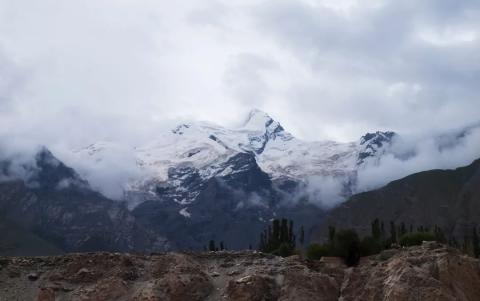
I watched the movie "Visitors from the Iceberg" a few years ago and learned that there is a place called the Pamir Plateau in a distant place. Later I learned that this plateau is not simple. It is the ancestor of all mountains and the source of all waters, with continuous snow peaks and magnificent scenery. Pamir was called Buzhou Mountain in ancient times. "The Classic of Mountains and Seas: Great Wilderness Western Classic" says: "Beyond the northwest sea, in the corner of the Great Wilderness, there are mountains that do not fit together, so they are called Buzhou."

 Baisha Lake, also known as Baisha, is located next to National Highway 314 of the China-Pakistan Highway, more than 100 kilometers away from Akto County in a straight line. The relative height of Baisha Mountain is about 460 meters and the length is 1,200 meters. In front of the mountain is Bulunkule Lake, and behind the mountain is Chakla Lake. The lakeside has lush water plants and waterbirds gather. The green mountain is covered with white sand, half-covered and half-covered, and undulating. Stretching, snow-capped mountains and lakes correspond to each other, which is so beautiful.
Baisha Lake, also known as Baisha, is located next to National Highway 314 of the China-Pakistan Highway, more than 100 kilometers away from Akto County in a straight line. The relative height of Baisha Mountain is about 460 meters and the length is 1,200 meters. In front of the mountain is Bulunkule Lake, and behind the mountain is Chakla Lake. The lakeside has lush water plants and waterbirds gather. The green mountain is covered with white sand, half-covered and half-covered, and undulating. Stretching, snow-capped mountains and lakes correspond to each other, which is so beautiful.

 On the Pamir Plateau at an altitude of more than 4,000 meters, between the white sand mountains, the lake water is pure and unstained by a trace of dust, reflecting the mountains and rivers.
On the Pamir Plateau at an altitude of more than 4,000 meters, between the white sand mountains, the lake water is pure and unstained by a trace of dust, reflecting the mountains and rivers.




 At the foot of Muztagh Peak, on the shores of Kalekul Lake, the water is as fine as scales, and the snow-capped mountains stand proudly in the distance. It is indeed a wonderful sight.
At the foot of Muztagh Peak, on the shores of Kalekul Lake, the water is as fine as scales, and the snow-capped mountains stand proudly in the distance. It is indeed a wonderful sight.





Some people say that if you don’t visit Xinjiang, you don’t know how big China is; if you don’t visit Xinjiang, you don’t know how beautiful China is. Only when you arrive in the legendary Kashgar in southern Xinjiang can you enter the real Xinjiang. Entering the Pamir Plateau from National Highway 314 (i.e. China-Pakistan Highway), passing through Baisha Mountain, Karakul Lake (also known as Ka Lake), Muztagh Mountain (7546 meters) and Gonger Mountain (7719 meters), until At the Khunjerab Port, you can truly experience the beauty of southern Xinjiang.


Looking from the outside, between the sky and the vast earth, it looks like a huge abandoned building block, "stacked" haphazardly there. Some of the "building blocks" have collapsed, exposing the "unclothed" walls. Some houses look like they have been patched and have gone through repeated repairs and have lost their original appearance.
 Kuoziqiyabexi means "high cliff earthenware family" in Uyghur
Kuoziqiyabexi means "high cliff earthenware family" in Uyghur


 Walking inside, I discovered that the lanes here are narrow and winding, with street buildings, small alleys, handicraft workshops everywhere, and raw earth buildings everywhere.
Walking inside, I discovered that the lanes here are narrow and winding, with street buildings, small alleys, handicraft workshops everywhere, and raw earth buildings everywhere.








 Although the houses here are dilapidated on the outside, they are not boring, and the inside of the houses are very clean. Even in the midst of decline, people still love life as always and do their best to make their homes beautiful. The layout has a strong Uyghur style and a sense of immediateness.
Although the houses here are dilapidated on the outside, they are not boring, and the inside of the houses are very clean. Even in the midst of decline, people still love life as always and do their best to make their homes beautiful. The layout has a strong Uyghur style and a sense of immediateness.



The city is alive and inhabited. Although the courtyard is simple, the ajar wooden door, the ladies chatting on the street, and the children playing all tell people: this is our home.



 Walking out of the old city and onto the street, watching donkey carts and tricycles passing by, there is something both ancient and fresh, vicissitudes of life and beauty. Kashgar is indeed a place with a complex, charming and remote temperament.
Walking out of the old city and onto the street, watching donkey carts and tricycles passing by, there is something both ancient and fresh, vicissitudes of life and beauty. Kashgar is indeed a place with a complex, charming and remote temperament.

